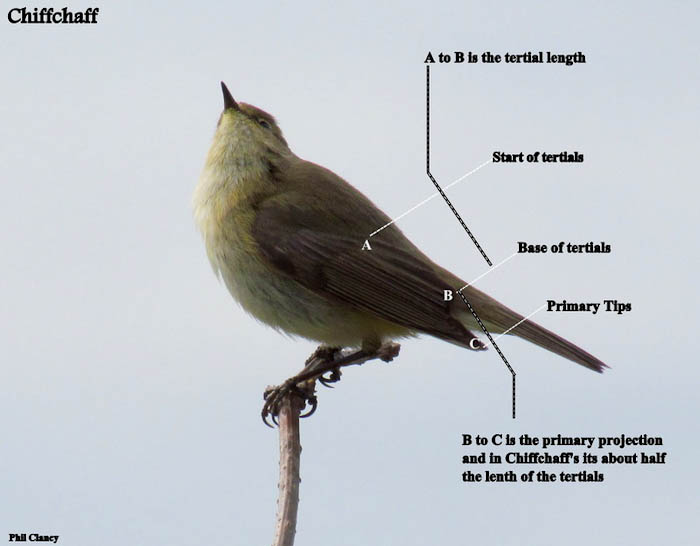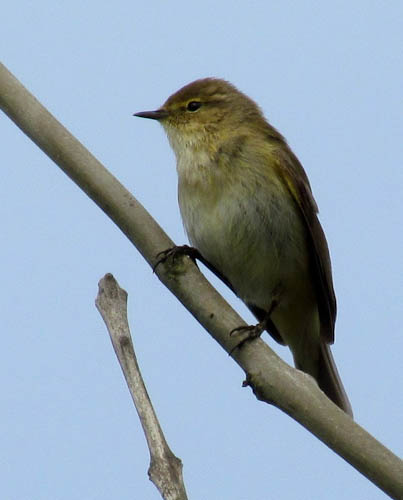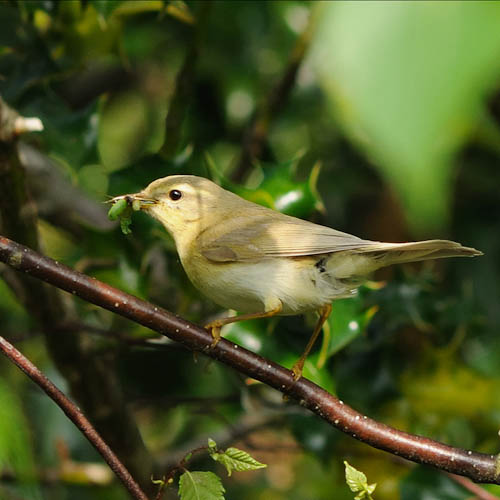| |
Identifying Chiffchaff &
Willow Warbler
Chiffchaffs and Willow
Warblers are two birds that most new birders struggle with.
They are both phylloscopus warblers, which means they are in the same
family as each other and as so look very alike. They are both small birds
with slender legs and bill. They both show greyish green and white plumage
with no striking features. Identification isn't helped by the fact that
they are both very lively birds; constantly on the move, flicking through
the foliage in search of flies and insects.
However with a little time and effort you will get to know these birds and
I guarantee that if you put the time in now, you will have no problem
identifying these birds in the future. There are a few key features to
look for and the main ones are as follows...
- LEG COLOUR is probably the easiest way of telling Chiffchaff from
Willow Warbler. However it is not foolproof but it is generally a good
guide line. Chiffchaffs have black legs and Willow Warblers have light
brown, flesh coloured legs. The problem with this feature is that Willow
Warbler leg colour can sometimes vary and birds with dark legs have been
seen but this is the rare exception to the rule.
- SONGS & CALLS.
The songs of these birds could not be more different and are well worth
learning. Chiffchaff is a very easy song to remember as the bird simply
says its name over and over again. A loud chiff-chaff, chiff-chaff,
chiff-chaff. The call is a loud "hweet". Willow Warblers have a
very fluid like song consisting of descending notes and once learned is
easy to remember. Call is a loud "hoo-eet".
- HABITAT. Although
both warblers are ground nesters, Chiffchaff's tend to inhabit taller
stands of deciduous trees and woodland. Willow Warblers can be found in a
variety of habitat, from parks and gardens to hedges and willow copses.
While on passage in spring and autumn both warblers can be found virtually
anywhere.
- PRIMARY PROJECTION.
If you ask any experienced birder how to tell Willow Warbler from
Chiffchaff, they will tell you that primary projection is the proper way
to do it and as so it's worth explaining. It's not as hard as it sounds
but it does requires a basic knowledge of bird topography, in particular
the different groups of wing feathers and where they are situated.
Basically it is the length that the primaries extend past the tertials and
how this relates to the tertial length e.g. in the figure below the
primary feather projection is only half the length of the tertials in
Chiffchaffs. Whereas in Willow Warblers the primary projection is equal to
the length of the tertials. This also indicates that Willow Warblers
travel further on migration. All the way to tropical Africa compared to
Chiffchaff which winters in the Mediterranean.

| Chiffchaff |
Willow
Warbler |
| Dark
legs |
Pale
legs |
| Dull
olive green upperparts |
Pale
grey green upperparts |
| -
a short pale supercilium |
-
a strong yellowish supercilium |
| -
off white underparts with |
-
and white belly |
| -
variable yellow tones |
-
yellowy
white throat & breast |
| Primary projection only half the
length of the tertials |
Primary projection equal to the tertial length |
| Song short and disyllabic -
repeated |
Song fluid and descending notes |
| Constantly flicks its tail |
Flicks tail every so often |
Now for the test! Can you tell what these two birds are?
 
Answers are ………
Chiffchaff on the left and Willow Warbler
on the right
|
Written by Philip
Clancy
Photos: Chiffchaffs by Philip Clancy
Willow Warbler by John Fox
|
|
|
|